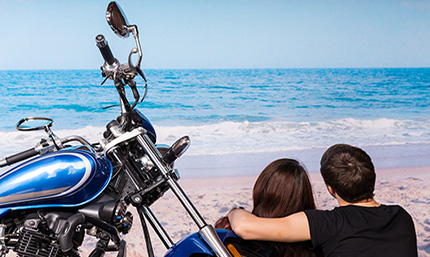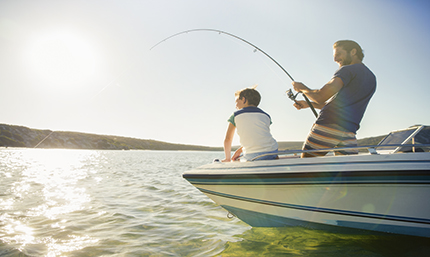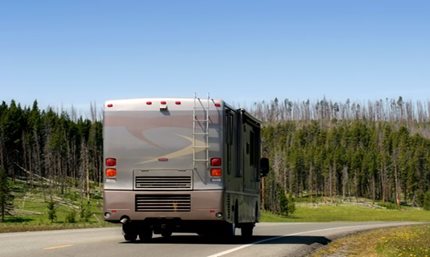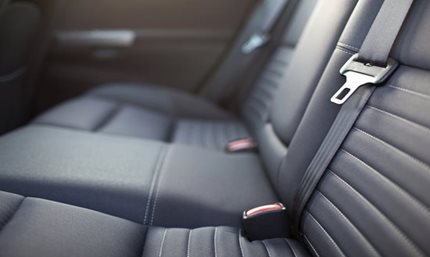News & Tips
5 Easy Steps to Finance a Motorcycle in Florida

Nothing beats the feel of the open air and the freedom of the road whether you’re riding solo or with a community of like-minded riders. A motorcycle gives you the opportunity to express your unique identity, connect with nature, and master new skills. Let’s take a look at the ins and outs of financing a motorcycle to help you get the bike of your dreams. From assessing your financial situation to exploring lender options, we’re breaking down motorcycle financing in these five steps.
Step 1: Gain an understanding of your financial bandwidth.
This step is really a two-parter: check your credit score and know what you can comfortably afford.
Check Your Credit Score
The better your credit score, the more options you’ll have for motorcycle financing. Did you know you have multiple credit scores, with each one relying on information from one of the three credit bureau agencies: TransUnion, Equifax, and Experian? You can check each of your three credit reports at annualcreditreport.com. If you see any errors, be sure to dispute them with the credit bureaus or the creditors because fixing them may help boost your scores.
With a good credit score, you have a better chance of getting approved for a higher loan amount and receiving a better rate. If you need to increase your credit scores, making your payments on time and keeping credit card debt to 30% or less of your total credit limit can help. Here is more information about credit scores and how to improve yours.
Know What You Can Comfortably Afford
See what amount fits into your budget (and if you haven’t made one yet, here’s how to create a monthly budget). Motorcycle loan terms can sometimes go up to seven years, but the longer your loan term, the more interest you’ll pay.
Besides your loan payment, keep in mind these costs, too:
- Potential down payment
- registration, taxes, and fees
- dealer fees
- maintenance plans and warranties
- jacket, helmet, boots, and other accessories
- insurance, which is partially based on your bike type and driving record
With these insights, you can be more informed as you move onto step two.
Step 2: Explore options for your motorcycle financing.
There are plenty of boxes to check off when seeking financing—whether you’re looking at dealership/manufacturer financing or at a credit union, bank, or online lender. Perhaps the most important: look at the annual percentage rates (APRs) offered because they take both the interest rate and fees into account. So, it’s a better apples-to-apples comparison than just looking at the interest rate offered.
Here’s what else to check out and compare:
- Application fees
- Repayment terms
- Prepayment penalties
- Other borrower requirements
Credit unions are not-for-profit organizations that focus on the financial health of their members, which typically offer better rates and lower fees than banks (as they’re for-profit organizations that answer to shareholders).
Here’s more information about our motorcycle loans at Space Coast Credit Union (SCCU).
Step 3: Weigh Pros and Cons of New Versus Used Motorcycles
Pros of buying a new motorcycle include:
- Better rates: Because new motorcycles are less likely to break down than used motorcycles and present less risk for lenders, you’ll often see better rates.
- Latest safety features: New motorcycles can come with the newest technology, including ones that help to prevent accidents and injury. Plus, because the bike is new, you don’t have to worry about any previous damage.
- Warranties: New motorcycles may come with them, which means that you’d pay less for repairs and maintenance with covered items.
Cons of buying a new motorcycle include:
- Cost: New motorcycles come at a higher price point than comparable used ones.
- More rapid depreciation: New vehicles, including motorcycles, lose value more quickly, especially in the first year or two.
Pros of buying a used motorcycle include:
- Better price: All other things being equal, you can usually get a used motorcycle for less money, which opens up ownership possibilities to more models.
- More types of places to buy: Because you can buy from dealers or private sellers, you can look for the best deal in more places.
- Holds its value: While a new motorcycle can dip in value as soon as you zoom off the dealer’s lot, that doesn’t happen with used ones. So, if you decide to resell after a little while, you might get a resale price that’s more comparable to what you paid.
Cons of buying a used motorcycle include:
- Used motorcycle loan rates: These are typically higher than rates on new ones. That said, you can still shop around to get the best used motorcycle loan rates available.
- Repairs and maintenance: You’ll likely need to go to the shop more often with a used motorcycle than with a new one.
| Type | Payment Period | APR* "As Low As" | Payment per $1,000 |
|---|---|---|---|
| Motorcycles and Scooters 2022-2026 | 36 Months Term determined by loan amount |
5.99% | $30.42 |
| Motorcycles and Scooters 2019-2021 | 36 Months Term determined by loan amount |
6.49% | $30.64 |
| Motorcycles and Scooters 2018 & Older | 48 Months Term determined by loan amount |
10.75% | $25.72 |
Rates shown are fixed Annual Percentage Rates and subject to change. Your actual rate and terms are affected by your creditworthiness, term selected, vehicle type, and model year. Certain restrictions apply. You may be asked to furnish a down payment. Florida loans are subject to Documentary Stamp Tax. The tax amount is not included in the quoted APR.
Scooters: Engine size of 50cc’s or greater will be treated as a motorcycle loan. Anything less than 50cc’s will be considered a signature loan.
Step 4: Get pre-approved!
Let’s cover the difference between pre-qualifications and pre-approvals.
With a pre-qualification (the simpler process), a lender might ask for annual income figures and total debt amounts without verifying the information. They may do a soft credit pull (which won’t impact your credit scores). All in all, the lender probably won’t invest any more time in giving you a general amount that you’d likely qualify for based on available information.
Pre-approvals involve more vetting by the lender. This would include verification of financial information you’ve provided, such as your income and debts, and probably a hard credit check. This allows the lender to give you a more accurate benchmark of what you’d qualify for with your motorcycle financing. Because of this, sellers take this information more seriously, giving you more credibility when shopping.
Submitting a few applications for pre-approval within a short timeframe doesn’t usually impact your credit score too much, as credit scoring models typically combine those into one hard inquiry on your credit report.
Step 5: Go shopping!
Now for the fun part! If you haven’t already, gather information from local dealers, motorcycle sites, manufacturers, and so forth. You can also go to online forums to see discussions about other riders’ preferences and experiences, and it helps to research safety features of bikes that interest you.
The motorcycle you choose should match your riding style, experience, climate, and intended purpose. If you’re new to riding, a motorcycle with manageable power, lighter weight, and rider aids may be a safer choice and even more affordable. New riders should also consider a certified rider course—some dealerships offer weekend classes that qualify you for your Florida motorcycle endorsement, which may help lower your insurance rates.
Riding style and bike selection:
What kind of riding do you plan to do?
- Urban commuting: Consider a sport bike, as these offer upright seating, lower-end torque, and easy maneuverability for stop-and-go traffic.
- Track riding: A sportbike like a Yamaha R7 or Kawasaki Ninja ZX-6R can deliver the performance and handling you need.
- Touring and long-distance riding: A sport-touring bike or adventure bike balances comfort and power for long hauls.
- Off-road and dual-sport: For rural areas or off-road adventures, a dual-sport or adventure bike may be the right fit.
When you’ve narrowed down your choices to a couple of kinds of motorcycles, check them out in person to see if they match your expectations. A model might look great on paper but may not be the one when you see it live. Is the motorcycle right for your height and your riding skill levels?
With a motorcycle endorsement and permission from the dealership or private owner, take the motorcycle for a spin. Ask yourself how comfortable you feel riding it and how the engines, brakes, and other features perform.
You can find more motorcycle financing and other tips here.
Benefits of a Credit Union Loan for Your Motorcycle Financing
Credit unions are not-for-profit organizations that make members their priority. Members (the name that credit unions give to customers) are the owners of the organization with their interests put front and center. So, credit unions like SCCU are continually looking for ways to provide members with products and services that help them achieve their financial goals.
In practical terms, that translates into lower new and used motorcycle loan rates and fees. SCCU offers the personal touch in all we do for members with lending decisions made locally.
Get Your Motorcycle Loan at SCCU
At SCCU, you can conveniently apply for a motorcycle loan pre-approval online. We offer flexible terms and low rates to those who are approved and meet the qualification requirements. A pre-approval will help streamline the buying process and give you leverage in negotiations, allowing you to focus on securing the best deal. Plus, you don’t have to worry about application fees. If you have any questions, feel free to get in touch with us.


















.jpg?width=430&height=257&ext=.jpg)




